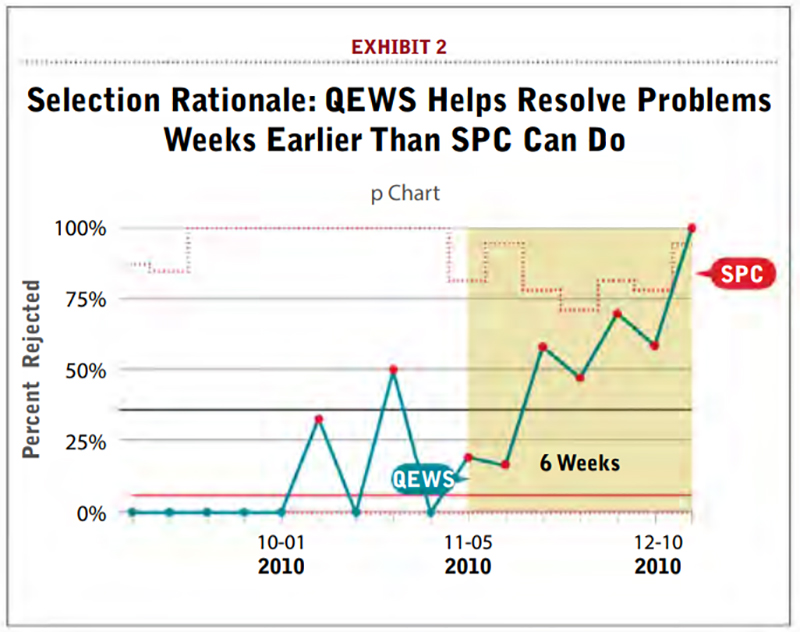Sorry, but your login has failed. Please recheck your login information and resubmit. If your subscription has expired, renew here.
March-April 2014
Retailers and distributors alike have attempted to solve their inventory challenges by using forecasting tools to determine what to buy and when to buy it. A better approach is to change the flow of inventory by reducing cycle times, more effective inventory positioning, and synchronizing supply chains based on the variability of demand. Browse this issue archive.Need Help? Contact customer service 847-559-7581 More options
These days, it is hard to avoid the mention of cloud computing during any ordinary work week. And with good reason: “Cloud,” as it is referred to, is rapidly becoming a valued means of storing, sharing, and retrieving all kinds of data at faster speeds and with far lower fixed costs than ever before. It was only a matter of time before cloud would be seen as a potential solution for some of the complex challenges that supply chain managers face in today’s non-stop global economy.
So what does the cloud-driven supply chain look like in practice? How are its advantages actually playing out? And what are some of the challenges and risks along the way?
IBM’s Integrated Supply Chain (ISC) organization has some answers. In 2012, ISC began taking to the cloud its Quality Early Warning System (QEWS), an innovative solution developed by IBM to identify potential quality defects in its end-to-end hardware supply chain processes. In addition to saving IBM an estimated $50 million in warranty costs, QEWS is an important step in IBM’s shift from descriptive, or reactive, analytics to predictive analytics.
 |
This complete article is available to subscribers
only. Click on Log In Now at the top of this article for full access. Or, Start your PLUS+ subscription for instant access. |
Not ready to subscribe, but need this article?
Buy the complete article now. Only $20.00. Instant PDF Download.
Access the complete issue of Supply Chain Management Review magazine featuring
this article including every word, chart and table exactly as it appeared in the magazine.
SC
MR
Sorry, but your login has failed. Please recheck your login information and resubmit. If your subscription has expired, renew here.
March-April 2014
Retailers and distributors alike have attempted to solve their inventory challenges by using forecasting tools to determine what to buy and when to buy it. A better approach is to change the flow of inventory by… Browse this issue archive. Access your online digital edition. Download a PDF file of the March-April 2014 issue.These days, it is hard to avoid the mention of cloud computing during any ordinary work week. And with good reason: “Cloud,” as it is referred to, is rapidly becoming a valued means of storing, sharing, and retrieving all kinds of data at faster speeds and with far lower fixed costs than ever before. It was only a matter of time before cloud would be seen as a potential solution for some of the complex challenges that supply chain managers face in today’s non-stop global economy.
So what does the cloud-driven supply chain look like in practice? How are its advantages actually playing out? And what are some of the challenges and risks along the way?
IBM’s Integrated Supply Chain (ISC) organization has some answers. In 2012, ISC began taking to the cloud its Quality Early Warning System (QEWS), an innovative solution developed by IBM to identify potential quality defects in its end-to-end hardware supply chain processes. In addition to saving IBM an estimated $50 million in warranty costs, QEWS is an important step in IBM’s shift from descriptive, or reactive, analytics to predictive analytics.
The group’s experience with cloud computing thus far has proved to be promising. The results provide ample justification for continued investment in cloud, particularly in terms of managing time and project commitments. This article shares some of what IBM has learned to date, gives candid disclosures about some of the pitfalls, and points to the next steps in moving more of IBM’s supply chain to the cloud.
IBM’s Supply Chain Imperative
Delivering information technology hardware, software, and services to over 170 countries, IBM generated 2013 revenues of almost $100 billion with net income of $18 billion. But like other Fortune 500 organizations, IBM is in white-hot competition for market share and client relevance.
Every efficiency gain matters; every opportunity to shift costs from fixed to variable is of great interest; every technology model that improves collaboration and reduces cycle time is of enormous value. “We can make ourselves a successful company,” Ginni Rometty, IBM’s chief executive said recently.
“But to be the world’s most essential company? Others confer that on us. We will have to earn that.” Pivotal to IBM’s effectiveness is its ISC organization, whose 20,000-plus employees in 70 countries manage more than $33 billion in annual spend for IBM and work
with more than 19,000 suppliers worldwide, all connected online.
The ISC owns and manages IBM’s end-to-end supply chain processes. This includes all of its supplier-facing source-to-payment processes and its client-facing opportunity-to-order-to-cash interactions, along with the conventional plan-to-deliver activities. It should come as no surprise that the ISC relies heavily on its IT prowess; more than 93 percent of supplier invoices are transacted electronically; and it has more than 30 analytics applications that are used to improve its global end-to-end operations.
The ISC’s leadership team had been well aware of cloud computing’s potential for years; after all, IBM has been a leading cloud proponent for a long time. (The enterprise has been growing its overall cloud revenues sharply in recent years; indeed, IBM reported 2013 cloud revenues of more than $4 billion—a 69 percent increase over 2012.)
But cloud’s value to ISC became clear in the fourth quarter of 2011 when Tim Humphrey, ISC’s director of strategy and innovation, identified it as a key enabler for IBM’s overall supply chain strategy—notably for increasing supply chain agility. Crucially, cloud would realign ISC’s strategy with IBM’s overall corporate strategy, which was already tightly tied to cloud computing.
The organization’s consequent cloud strategy was developed and reviewed by Tom Ward (co-author of this article and ISC’s supply chain cloud strategist), and approved by Fran O’Sullivan, IBM’s chief supply chain officer and her senior supply chain executive team.
The strategy was established by conducting over 40 interviews across IBM’s supply chain, with executives in the office of its chief information officer, and with its Global Technology Services’ executive teams.
In addition, available industry research was evaluated to identify the intersection between cloud and the supply chain. The primary benefits of cloud were already well understood by the team. These were anchored in the definition of cloud from the National Institute of Standards and Technology (NIST). (See Cloud Made Clear.)
ISC leaders knew it would provide faster access to IT resources and the elastic capacity needed to make IBM’s supply chain more agile. They were familiar with the ways in which cloud service providers could speed up “time to value” in terms of clients’ access to the cloud. They knew that the cloud can open up multi-enterprise collaboration among suppliers, clients, and business partners, boosting supply chain efficiency.
(In a traditional IT environment, server utilization is typically 15 percent to 25 percent, whereas in the cloud, it can be more than 65 percent.) And they understood that improved visibility of key data would make supply chains more responsive. The question was, where, across all of IBM’s farflung supply chain operations, could cloud be piloted to best effect?
The ISC’s leaders pinpointed three areas in which cloud could make big contributions:
- Reducing the cycle time for on-boarding clients to the cloud
- Trimming cycle times for delivery and set-up of cloud infrastructure for IBM’s and its clients’ data centers
- showcasing the migration of IBM internal supply chain applications to the cloud
Cloud Made Clear
Cloud computing has been compared to renting a car versus owning a car. Under a car rental agreement, the renter pays for the use of the car on a consumption basis: A renter is charged by the day or by the mile driven. The car is rented from a fleet of cars of different sizes, makes, and models.
The renter can readily opt for an “upgrade” car if he or she needs more capacity or speed. The National Institute of Standards and Technology (NIST) defines “cloud” as follows: Cloud computing is a model for enabling ubiquitous, convenient, on- demand network
access to a shared pool of configurable computing resources (e.g., networks, servers, storage, applications, and ser vices) that can be rapidly provisioned and released with minimal management effort or service provider interaction.
The fundamental benefits of cloud computing are ease of use and speed of provisioning. It is important to note that cloud is not a “technology,” like networking or server storage; it is a usage model. It is based on a pool of network, compute, storage, and application resources. Treating all the resources in the data center as a pool enables users to more accurately quantify the business value of cloud computing as a solution at each stage of implementation.
Shortlisting Applications for The Cloud
With those objectives in mind, Tom Ward and other ISC leaders began to map out a supply chain cloud deployment plan in mid-2012. At least 12 of IBM’s existing supply chain applications were identified as strong candidates to migrate to the cloud—applications ranging from Web order invoicing, and online travel reservations to critical parts management tools.
The evaluation process mapped the cloud’s desirable characteristics (as defined by NIST and ISC) to the fit with each application. This assessment was based on a supply chain application running on an Infrastructure as a Service (IaaS) environment. To launch the initiative, the ISC cloud team began to identify and assemble professionals from across the company who could help drive the cloud pilot program.
As part of IBM’s global technical talent development program, three ISC employees from India, Chile, and Spain worked with Ward and IBM distinguished engineer Pascal Durazzi to identify and evaluate candidate applications. By 2013, three new staff members—including co-author Vasanthi Gopal, an IBM IT architect—had joined the team to drive ISC’s cloud application migration.
Importantly, the cloud strategy effort required no full-time employees. Ward has been allocating approximately 30 percent of his working week to the project; Gopal commits one day a week as part of her own ongoing training and development initiative at IBM. All
in all, the ISC’s cloud strategy initiative has required the equivalent of perhaps one full-time person thus far.
Additionally, the team took five key steps:
- Evaluating the cost for migration and on-going operations
- Comparing cloud-based costs to the business-as-usual environment
- Completing a security risk assessment in order to mitigate any security exposures
- Completion of a client enablement questionnaire to activate the service and provision the client’s initial resource
- Last but by no means least, the detailed planning for deployment of the application’s migration to the cloud

QEWS Gets the Green Light
The team selected a quality management solution, Quality Early Warning System (QEWS), for the pilot. Developed in-house by IBM, QEWS has been in use in IBM’s Server and Storage manufacturing operations worldwide since 2008. Its advanced analytics help detect emerging negative trends in supply chain quality early in the process.
The tool monitors and analyzes data that was already available in IBM’s information repository, such as full field performance data, manufacturing and test performance data, and supplier quality performance data. When an outlier is identified, QEWS proactively sends an alert to the appropriate manager, who can evaluate and confirm that there is a potential quality related defect and initiate the necessary remediation.
Specifically, QEWS provides an alternative to the current standard in quality—statistical process control (SPC)—which is prone to many false alarms and is reactive rather than predictive. QEWS’ “smart” infrastructure automatically detects defect trends typically before they are triggered by traditional, industry standard SPC techniques.
Using this predictive approach to quality management, IBM can identify and resolve potential problems six to eight weeks or more earlier than with traditional SPC at any stage of the supply chain process. The result: QEWS minimizes manufacturing rework, delayed product shipments, warranty claims in recall of defective products—all of which can and do contribute to lost time, higher costs, and lower client satisfaction.
QEWS can mitigate these problems while lowering costs, improving productivity, and enhancing brand value. Benefits to date at IBM include savings of $50 million in hard warranty costs since 2008, plus soft savings and benefits. In 2012, QEWS was recognized by
InformationWeek as a leading innovation.
And it was a finalist in the technology category of the Institute for Supply Management’s (ISM) 2013 awards. Perhaps more importantly, QEWS illustrates IBM’s shift from descriptive to predictive analytics. It is one of over 30 supply chain analytics solutions currently in use.
The application was recommended for the pilot program by Donnie Haye, ISC’s vice president of analytics, solutions, and acquisitions. Haye based her recommendation on the fact that the QEWS sits at the intersection of business analytics and the cloud across IBM’s suppliers, its clients, and IBM itself.
Analytics help unearth insights that inform business decisions and can be used to automate and optimize business processes. Cloud is a key enabler for integrating analytics applications and providing visibility across the supply chain. Moreover, QEWS was already gaining interest as a “showcase” application, for demonstration to IBM’s clients; moving it to the cloud could make it easier to use in future collaborations with clients, suppliers, and business partners.
The application can be used across many of IBM’s clients’ manufacturing industries, from automobile to electronics. The advantage of having QEWS in the cloud is that it makes it easier and faster to integrate with a client’s IT infrastructure. The client portal can be customized, and the user can choose the type of data to be displayed.

The Migration Begins
In February 2013, the push to put the QEWS application on the cloud began in earnest. By March 2013, the ISC cloud team was focused firmly on technology questions, such as deciding which cloud infrastructure to select. Some platforms, such as OpenStack, CloudStack, and Cloud Foundry, are gaining popularity, but no single standard has been widely adopted yet. (IBM supports infrastructure as a service (IaaS) on OpenStack and platform as a service (PaaS) on Cloud Foundry.)
The ISC team decided to migrate QEWS to IBM Cloud Managed Services (CMS). The team secured funds from the group’s “Smarter ISC Fund”—leveraging an internal source for financing innovation projects—in order to use the IaaS layer. IBM Cloud Managed Services (CMS) was chosen for several reasons.
CMS includes both the System x (Wintel) and Power System (AIX) IBM servers. The Power System provided for enterprise level application support. And CMS offered software and service options (operating system, middleware including Websphere, installation, and
support). Crucially, from IBM’s standpoint, CMS can be readily scaled and applied by any company that manufactures and sells physical products, ranging from heavy industrial equipment to medical devices, globally.
That is true for a private cloud environment or for one in a hybrid cloud, shared with other companies. By April, the emphasis had shifted to security. Given the sensitivity of supply chain data, which regularly includes clients’ names and delivery addresses, details of suppliers’ pricing, and terms and conditions, it is easy to understand why ISC executives such as Haye were anxious to confirm that the cloud offering would be secure enough to prevent Client A from seeing Client B’s data or IBM’s own data.
Moreover, QEWS encompasses an abundance of quality performance data and information about supply chain risks. And since QEWS is an enterprise level IBM application, and is therefore tightly integrated with many other company wide operations and processes, the security review required significant work.
IBM has robust policies and practices around information security management, which supply chain applications such as QEWS must comply with globally. Another benefit of using the CMS cloud was that it is compliant with IBM’s stringent corporate requirements for security management.
By September 2013, the ISC team’s activities had begun to pivot toward IT migration—that is, how to actually load the supply chain software into the cloud. The migration of QEWS to CMS took longer than expected; Ward’s team—and the ISC executives—had hoped it would take weeks, but in fact it took several months.
What was not immediately obvious was the difference between applications that are “cloud native”—developed on the cloud—and those that are not. To strengthen the security around QEWS on the cloud, the team accounted for the fact that QEWS was already plumbed in tightly to a wide range of existing data sources.
Lessons Learned
Cloud computing is a flexible and powerful technology model—one that can quickly eliminate the constraints imposed by traditional computing. The ability to access huge volumes of computing power, to dial up or dial down usage as needed, and to choose between private, public, or hybrid versions of the cloud has shown IBM’s ISC group that the cloud is of real and enduring business value.
ISC’s early forays into harnessing cloud for the supply chain has given its leaders every confidence that the technology model can prove valuable in many other applications beyond QEWS. As such, authors Ward and Gopal and their colleagues began migrating a second application toward the end of 2013—an application that suppliers will be able to access.
Work is well under way to move other ISC applications into the cloud. The ISC cloud team is presently evaluating three other applications to migrate to the cloud, one of which shares QEWS’ development and test environment. This has allowed the team to very quickly provision and dedicate new servers to the new application—in days, not weeks.
The CMS-based infrastructure is now being opened up to the developers of the new application so they can install and test it in the enterprise level cloud environment. Once it has been demonstrated that this second application can run on the cloud, the ISC team can then scale up the platform to put another mission critical application into production on the cloud.
As a result of its efforts, the ISC team has learned a lot in a short time. One important takeaway from the longer than expected migration of QEWS is that ideally, such applications should be built on the cloud in the first place
rather than trying to retrofit them onto the IaaS layer.
Another lesson: Cloud deployments can be surprisingly low cost. In 2013, Ward and his team used only 70 percent of the money allocated for the cloud platform.
Another positive surprise: Now that the infrastructure has been installed, it has proved extremely facile to onboard other clients. As noted earlier, the QEWS solution is of practical importance outside of IBM. Since going live, ISC has begun work with major automotive
industry clients to use QEWS in their manufacturing processes.
The cloud deployment provides a straightforward way for IBM to demonstrate the benefit ts it has realized and it enables clients to quickly use their own data to realize QEWS advantages. A client can rapidly access QEWS online, download its own data, and run its own analysis.
What is perhaps most interesting is the speed with which new applications can be brought online now that the team has properly mapped out the cloud infrastructure. Essentially, new applications can be ported over to the cloud in just a few weeks, whereas the QEWS application took six months to reach that stage.
At the time of this writing, cloud’s element of speed was evident in the ISC group’s entry in an internal competition at IBM. The contest—a fun way to spur excellence in internal communications and to help convey cloud’s proliferation within IBM—involves all of IBM’s cloud teams voting on the best way that such messages are communicated.
The imagery used on the ISC group’s entry—racing aircraft, with the tagline “expect the unexpected—faster with analytics”—amply sums up how cloud computing is helping IBM’s supply chain speed into the future.
SC
MR

More Cloud
- AI Simulation Takes Its Place Among Supply Chain Forecasting Tools
- 52% of Enterprises Have Moved to the Cloud
- Cloud computing needs installed based planning
- The cloud hovers over fast software supply chains
- Cloud gains favor for supply chain labeling
- 7 business-boosting benefits of cloud labeling solutions
- More Cloud
Latest Podcast

 Explore
Explore
Software & Technology News
- Survey reveals strategies for addressing supply chain, logistics labor shortages
- AI, virtual reality is bringing experiential learning into the modern age
- Humanoid robots’ place in an intralogistics smart robot strategy
- Tips for CIOs to overcome technology talent acquisition troubles
- Game on: Rethinking change management for the digital era
- Predicting stockouts: Enhancing FMCG resilience through data-driven insights
- More Software & Technology
Latest Software & Technology Resources

Subscribe

Supply Chain Management Review delivers the best industry content.

Editors’ Picks





